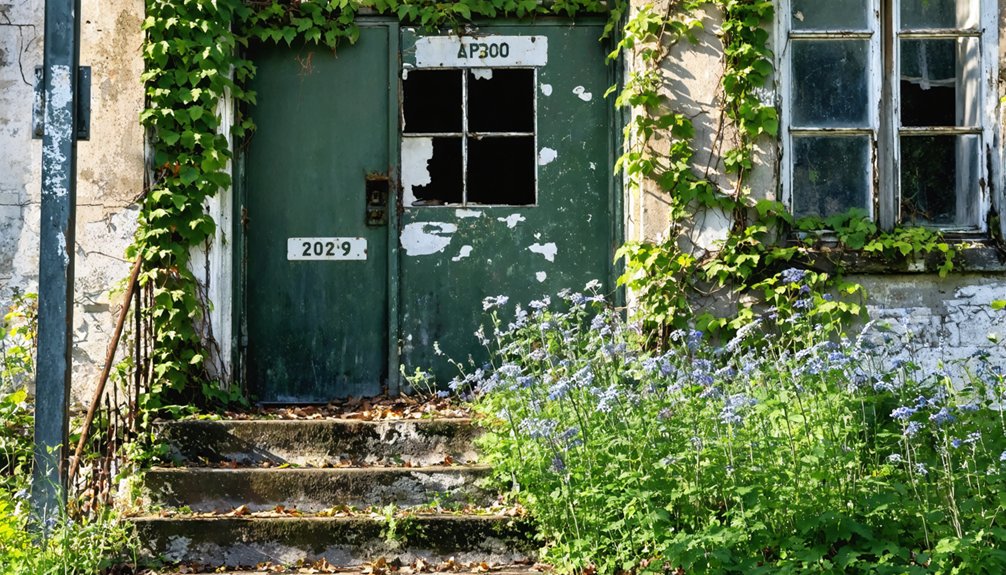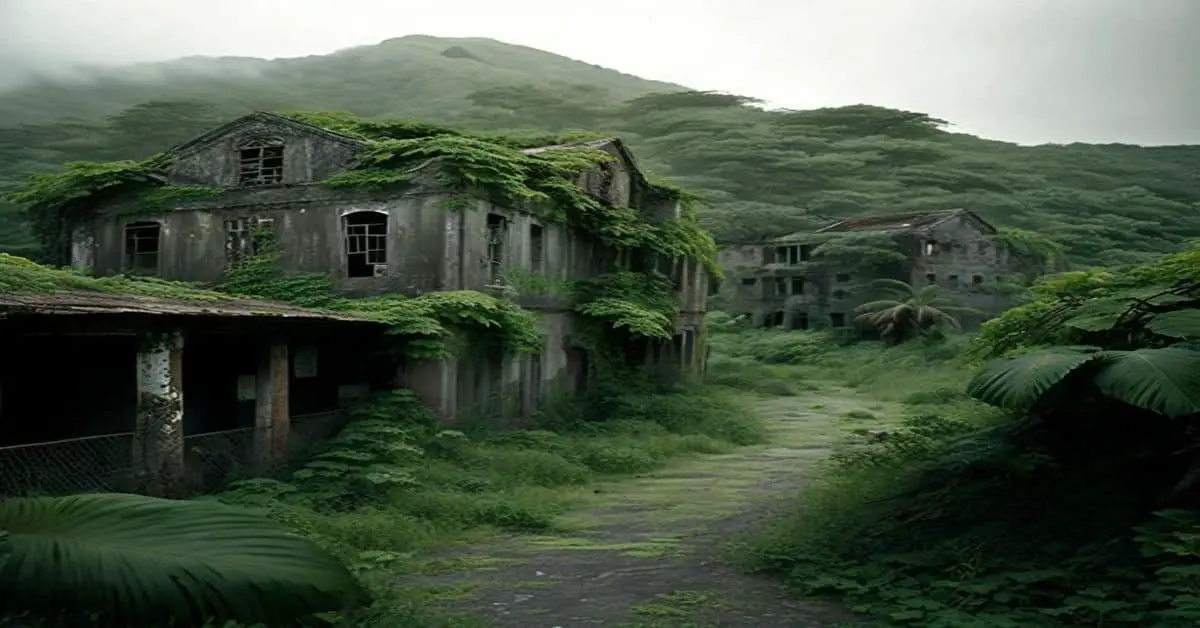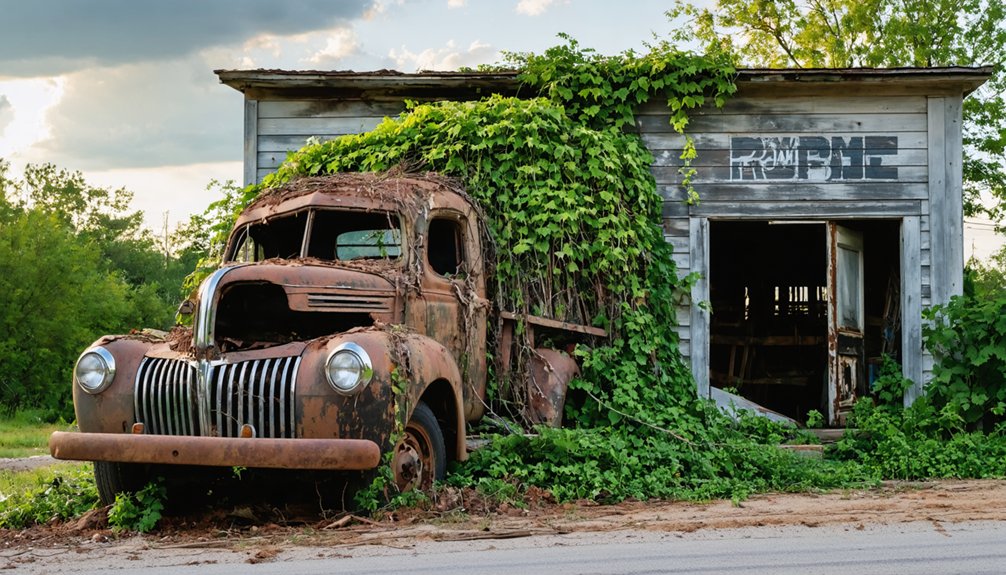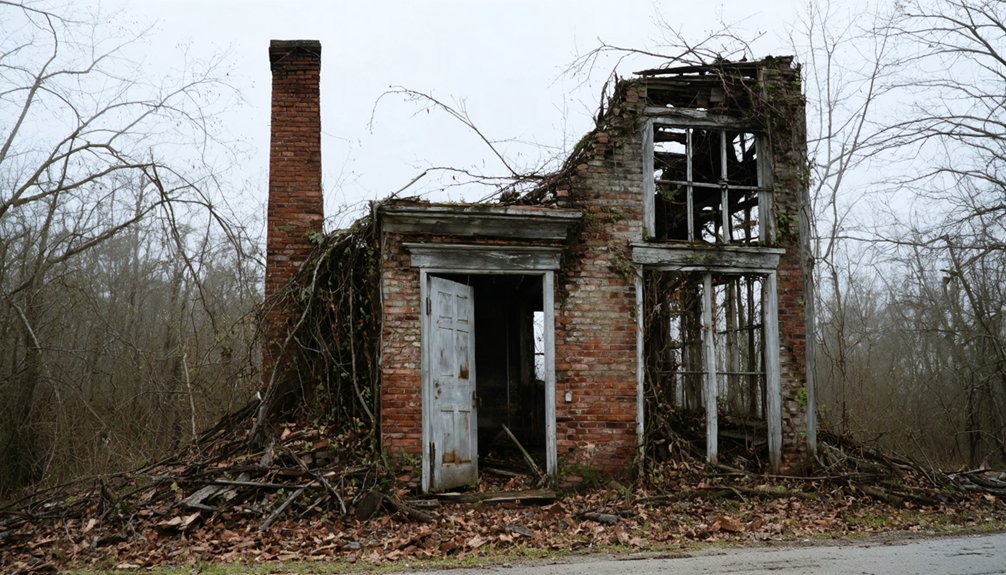You’ll find Fort McClellan‘s abandoned structures scattered across 10,000 acres near Anniston, Alabama. This once-bustling military installation trained over 500,000 personnel during WWII before closing in 1999. Today, empty barracks, theaters, and training facilities stand as silent witnesses to 81 years of military history. While environmental concerns from toxic contamination persist, the site’s transformation continues with mixed-use development plans promising new life for this historic ghost town.
Key Takeaways
- Fort McClellan closed in 1999 after 81 years of operation, leaving numerous abandoned military buildings and facilities across 10,000 acres.
- The closure resulted in 10,000 military and 1,500 civilian job losses, drastically impacting the local economy and community structure.
- Many original structures remain abandoned, with nature gradually reclaiming buildings that once housed training facilities, barracks, and support services.
- The site contains three distinct layers of military architecture spanning from early 1900s to 1990s, creating a time capsule of military history.
- Development plans aim to transform abandoned areas into mixed-use spaces, though many historic structures remain untouched and deteriorating.
The Rise of a Military Powerhouse
When Camp McClellan first opened its gates in 1917 as a World War I training center, few could have predicted its transformation into one of America’s premier military installations.
Under Colonel Jenkins’ leadership, military innovation took hold as the base rapidly expanded its infrastructure, constructing everything from igloo magazines to a massive amphitheater.
You’ll find the strategic significance of Fort McClellan reflected in its $17 million infrastructure investment and the acquisition of over 22,000 acres of training terrain.
By 1941, you could traverse 47 miles of paved roads connecting 27 warehouses and facilities capable of supporting 40,000 personnel.
The base’s sophisticated infrastructure included multiple swimming pools, theaters, and service clubs, creating a self-sufficient military city that would shape America’s defense capabilities for generations to come.
The fort also became home to thousands of German and Italian POWs during World War II, who left their artistic mark through distinctive murals in Remington Hall.
By February 1919, the installation had grown to include 1,534 buildings, making it one of the largest military facilities of its time.
Training Grounds During World War II
Fort McClellan’s robust infrastructure proved invaluable as World War II transformed the installation into one of America’s largest training centers.
During World War II, Fort McClellan’s strong foundation enabled it to become a vital hub for military training across America.
You’d find nearly 500,000 military personnel honing their combat skills through intensive programs that simulated real battlefield conditions. The historical significance of this training ground can’t be understated – it shaped America’s fighting force. Originally established as Camp McClellan in 1917, the facility played a crucial role in military preparedness.
By 1944, the base reached its peak wartime capacity with 2,170 officers and over 42,000 enlisted personnel.
The installation’s thorough military training included:
- Eight-to-nine-week basic training programs featuring weapons instruction, night maneuvers, and urban warfare
- Specialized training for diverse units, including the 92nd Infantry Division and Women’s Army Corps
- Advanced combat scenarios with live artillery fire and tank drills
Fort McClellan also served as a POW facility, housing 3,000 German and Italian prisoners between 1943 and 1946, further cementing its pivotal role in the war effort.
A Hub for Diverse Military Units
Throughout its operational years, McClellan served as a dynamic melting pot of military diversity, hosting an extraordinary mix of specialized units that shaped American military history.
You’ll find that ethnic diversity defined the base’s character, from the 27th Infantry Division‘s pre-Pearl Harbor presence to the groundbreaking 92nd Infantry Division with its 6,500 Black troops.
The fort’s military camaraderie extended across boundaries, incorporating segregated Women’s Army Corps detachments and even a unique Japanese American company that helped train U.S. forces in cultural awareness.
Even German and Italian POWs, numbering 3,000, contributed to the base’s rich tapestry, leaving behind artistic legacies like the murals in Remington Hall.
The Women’s Army Corps School established a permanent presence at the fort, making it a crucial training ground for female service members.
This convergence of different backgrounds created an unparalleled training environment that strengthened America’s military capabilities.
Life Behind the Gates
Behind Fort McClellan‘s gates lay a bustling, self-contained military city that served thousands of service members and their families.
Spread across 10,000 acres of land, the installation provided extensive space for both training and community development.
You’d find everything from schools and chapels to movie theaters and sports fields, creating a tight-knit community where military ceremonies and social gatherings brought people together.
Life at McClellan centered around three core aspects:
- Housing designed for rank – enlisted personnel lived in barracks while officers enjoyed separate quarters
- Daily necessities – post exchanges, mess halls, and medical facilities supported everyday life
- Recreation options – gyms, clubs, and entertainment venues provided escape from military routine
Despite challenging conditions during WWII, when temporary wooden structures housed the surge of trainees, the base evolved to offer improved living quarters with modern amenities and extensive support for its diverse military population. The Women’s Army Corps called Fort McClellan home until its retirement in 1977, contributing to the installation’s unique military culture.
Environmental Legacy and Health Concerns
You’ll find Fort McClellan’s contaminated legacy spans 67 disposal sites containing everything from chemical warfare agents and radioactive materials to PCBs and volatile organic compounds.
The toxic exposures have left veterans battling serious illnesses, including cancers and respiratory diseases, while struggling to prove their service-connected conditions to the VA.
Environmental testing has revealed widespread contamination in soil and groundwater extending up to 2,000 feet from original sites, though recent remediation efforts show declining pollutant levels. Testing showed lead in residential soil posed particular risks to children living on base, especially in homes built before 1978. A groundwater treatment program using eco-friendly injections was implemented in 2017 to help naturally break down the harmful pollutants.
Chemical Contamination Sites
During its operational years, Fort McClellan harbored numerous chemical contamination sites that left a complex environmental legacy requiring extensive cleanup efforts.
You’ll find that chemical exposure risks stemmed from 67 distinct disposal sites across the base, where various toxic substances threatened both military personnel and nearby communities. For veterans seeking disability claims, establishing a service connection remains challenging due to the lack of presumption status.
The contamination included:
- Radioactive compounds like cesium-137 and cobalt-60, used in decontamination training
- Chemical warfare agents, including mustard gas and nerve agents in controlled areas
- PCBs from the neighboring Monsanto plant, along with VOCs and TCEs in multiple disposal sites
The EPA’s involvement led to significant cleanup efforts, particularly at landfill sites contaminated with TCE and VOCs.
Despite remediation work, the base’s environmental impact continues to influence health concerns for veterans and local residents.
Health Impact On Veterans
While the VA acknowledges certain chemical exposures at Fort McClellan as harmful, veterans face significant challenges proving their health conditions stem from their service at the base.
You’ll find reported health risks including cancers, respiratory illnesses, neurological disorders, and chronic diseases linked to exposure to PCBs, nerve agents, and chemical warfare substances.
Despite veteran advocacy groups pushing for recognition, the VA hasn’t established presumptive conditions for Fort McClellan veterans.
You’ll need strong medical evidence and often legal support to successfully file disability claims.
The PACT Act of 2022 requires studies on health trends among Fort McClellan veterans, but conclusive findings could take years.
Meanwhile, veterans continue reporting adverse effects from multiple environmental exposures they encountered during their service at the base.
Environmental Testing Results
Environmental testing at Fort McClellan has revealed extensive contamination across multiple hazardous substances, with lead and PFAS compounds emerging as primary concerns.
You’ll find soil contamination exceeding 400 ppm lead levels near multiple buildings, while PFAS risks span across fire training areas, stations, and testing zones.
Testing results highlight three critical findings:
- Lead concentrations surpass Army action levels in five locations, threatening potential health impacts.
- PFAS compounds exceed screening levels in soil, groundwater, and surface water.
- Chemical warfare residues and radiological materials, though used under controlled conditions, leave uncertain environmental impacts.
Further sampling continues to map contamination plumes and exposure pathways, guiding necessary cleanup efforts to protect your health and restore environmental safety.
The Day the Gates Closed
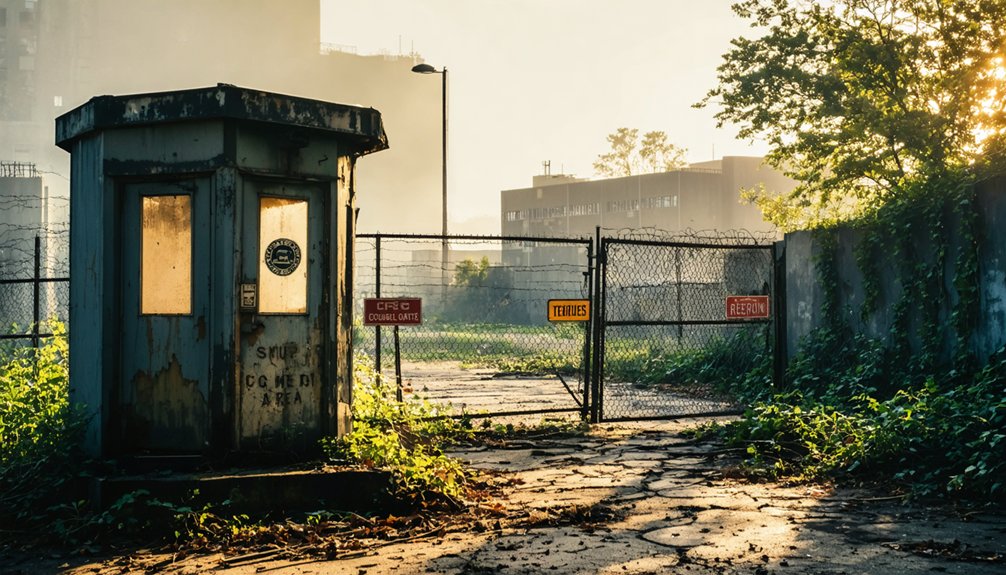
After eighty-one years of continuous military operations, Fort McClellan held its final closure ceremony on May 20, 1999.
You’d have witnessed the end of an era that trained thousands of service members through two world wars, Vietnam, and countless other conflicts.
The military shift dispersed Fort McClellan’s core operations across the nation – the Chemical School and Military Police School relocated to Fort Leonard Wood, Missouri, while the DoD Polygraph Institute moved to Fort Jackson, South Carolina.
The gates closing that day marked more than just a base shutdown.
It represented the loss of 10,000 military and 1,500 civilian jobs, delivering a $600 million annual economic blow to the local community.
While the area would recover 94% of civilian jobs by 2005, the closure forever changed Anniston’s landscape.
Echoes of the Past: Abandoned Buildings
Standing as silent sentinels across the former military installation, Fort McClellan‘s abandoned structures tell a haunting story of America’s military past.
From the mysterious “3252” Barracks to the sprawling “Starships” complex, you’ll find architectural significance in every corner of this decommissioned base nestled against the Choccolocco mountains.
Urban exploration reveals three distinct layers of military heritage:
Fort McClellan’s abandoned corridors reveal a layered history, with each era’s architecture telling its own military story.
- Early 20th-century designs influenced by City Beautiful movements
- Cold War-era infrastructure with over 870 buildings
- 1990s-era facilities left frozen in time
You can still trace the base’s evolution through its abandoned concrete buildings, boarded-up barracks, and deteriorating administrative facilities.
While nature slowly reclaims these structures, they stand as powerful reminders of Fort McClellan’s role as the military “showplace of the South.”
Hope for Future Development
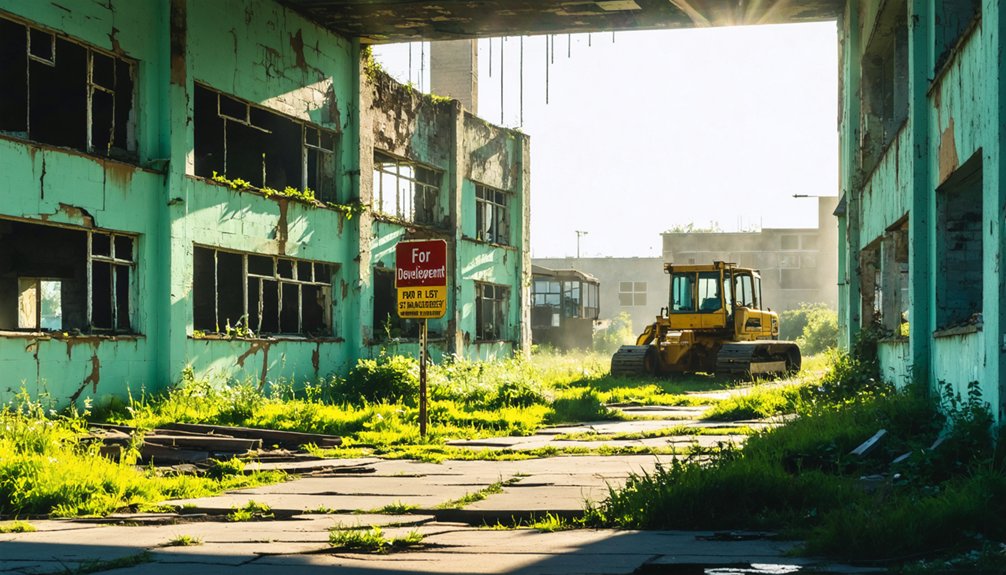
You’ll find substantial economic potential in Fort McClellan’s transformation as the City of Anniston takes control with streamlined development processes and enhanced tax incentives.
The city’s all-encompassing plan targets mixed-use development, combining residential renovations of former military housing with commercial spaces and industrial zones along the strategic I-20 corridor.
Your investment opportunities include the historic McClellan Headquarters complex, which offers 224,550 square feet of space with Opportunity Zone benefits and positions the area for a research triangle connecting major Alabama universities.
Mixed-Use Development Plans
Fort McClellan’s sprawling 10,000-acre site presents ambitious mixed-use development opportunities under the guidance of the McClellan Development Authority (MDA).
You’ll find extensive plans that maximize the property’s potential through residential, commercial, industrial, and educational development zones.
The site’s transformation prioritizes three key elements:
- Strategic land acquisitions by companies like Creedmoor Sports, demonstrating strong growth potential
- Active community engagement through public meetings and planning processes to shape development
- Infrastructure improvements including multi-use trails and modern amenities
You can take advantage of tax incentives in designated Opportunity Zones while preserving the site’s historic character.
With the potential transfer of development authority to Anniston, you’ll see streamlined processes and expanded economic tools to accelerate growth and investment opportunities.
Economic Revival Strategies
While the McClellan Development Authority leads the site’s economic revival, a complete strategy combines workforce development, infrastructure improvements, and public-private partnerships to accelerate growth.
You’ll find ready-to-develop industrial and commercial parcels with existing infrastructure, enhanced by the planned Eastern Bypass access.
The focus on workforce training through a new Adult Education Center and partnerships with local universities guarantees you’ll have access to skilled labor.
Tax abatements and other city incentives make redevelopment opportunities more attractive for your investment.
The mixed-use zoning allows flexibility in development, while infrastructure upgrades in North Anniston support sustainable growth.
Through coordinated efforts between the MDA, city government, and private developers, you’re looking at an all-encompassing approach to transform this former military site into a thriving economic hub.
Frequently Asked Questions
Are There Ghost Stories or Paranormal Activities Reported at Fort Mcclellan?
You’ll find numerous ghost sightings at Fort McClellan, one of Alabama’s most haunted locations. Visitors report seeing shadowy figures, apparitions in white, experiencing cold spots, and hearing unexplained sounds.
What Happened to the German POW Artwork After the Fort Closed?
You’ll find the German POW artwork still adorning Remington Hall’s walls, though abandoned and deteriorating. While some murals face preservation challenges from weather and time, they remain as silent witnesses to history.
Can Visitors Explore Fort Mcclellan Today, and Are Tours Available?
You’ll find limited Fort access, as most areas are restricted or redeveloped. While organized tours aren’t regularly available, you can visit public sections and the Center for Domestic Preparedness by appointment.
What Valuable Artifacts Were Left Behind When the Base Closed?
You’ll find military relics like chemical training facilities, World War II structures, archaeological artifacts from 129 sites, and Cold War-era buildings of historical significance, though many items’ locations remain unknown.
Did Any Famous Military Personnel Serve or Train at Fort Mcclellan?
Like stars in the service sky, you’ll find Fort McClellan’s famous alumni include General George S. Patton, who trained troops there, and countless Women’s Army Corps leaders shaping military legacy.
References
- https://armybases.org/fort-mcclellan-al-alabama/
- https://encyclopediaofalabama.org/article/fort-mcclellan/
- http://www.militarybases.us/army/fort-mcclellan/
- https://en.wikipedia.org/wiki/Fort_McClellan
- https://www.youtube.com/watch?v=nI0Glf_dUaI
- https://mcclellan.usace.army.mil/Info.asp
- https://www.publichealth.va.gov/exposures/fort-mcclellan/
- https://www.sam.usace.army.mil/Portals/46/docs/library/FM/Miscellaneous/Fort_McClellan_A_Popular_History_Undated_filed_in_December_2003_area/Ft_McClellan_A_Popular_History.pdf
- https://alabamanewscenter.com/2019/07/18/on-this-day-in-alabama-history-camp-mcclellan-was-established-in-east-alabama/
- https://tile.loc.gov/storage-services/master/pnp/habshaer/al/al1300/al1311/data/al1311data.pdf
